
Energy efficiency policies ‘could save UK homes £270’, report finds
Jocelyn Timperley
09.06.17Jocelyn Timperley
06.09.2017 | 7:40amUK homeowners could cut their yearly bills by hundreds of pounds by making their properties more energy efficient, a new report says.
“Cost-effective” investments up to 2035 could save a quarter of the energy used by households, the UK Energy Research Council (UKERC) report says, worth an average of £270 per household per year at current energy prices. This would come on top of savings already made.
Around 140 terawatt hours (TWh) of energy would be saved – roughly equivalent to the output of six Hinkley C-sized nuclear power stations, it notes, though savings would be in heat as well as power.
The investments would deliver net benefits worth £7.5bn to the UK, the analysis found, using the government’s own guidance for policy appraisal. This could reach £47bn, if benefits such as health improvements and additional economic activity are counted.
The report calls for the government to set a long term target for energy efficiency – in a similar way as it recently pledged to ban petrol cars by 2040.
The UK’s long delayed Clean Growth Plan would be a good platform for this, the authors say.
Efficiency gap
British homes now use 23% less gas and 17% less power than in 2008, in large part due to the use of more efficient appliances and increased insulation.
Improved energy efficiency since 2004 mean the average dual fuel household bill was £490 lower in 2015 that it otherwise would have been, the report notes.
However, progress on energy efficiency has stalled as government policy has tailed off. Two years after the government scrapped its Green Deal energy efficiency loan scheme, it has yet to announce a replacement.
The Committee on Climate Change (CCC) recently highlighted energy efficiency as a priority in efforts to reduce the UK’s carbon emissions. It said the government should increase the delivery of energy efficiency measures, heat networks and heat pumps in cost-effective locations for both households and businesses.
In its own impact assessment for the fifth carbon budget, the UK government concluded that the domestic buildings sector has the highest technical potential for carbon abatement across the economy, above transport and agriculture.
Cost-effective
Today’s report focuses on measures whose cost could be recouped in energy savings relatively quickly, using the standard discount rates.
This “cost-effective” scenario includes savings due to reduced energy use and a valuation of factors such as improved comfort, better air quality and lower carbon emissions.
This scenario is broadly in line with the CCC’s approach to meeting the fifth carbon budget at least cost, the report says. It would also keep the UK on track towards the deeper emissions cuts necessary by 2050, under the Climate Change Act,
The chart below shows how seven key technologies could reduce household energy demand under the “cost-effective” scenario (black dotted line). This is compared to a baseline scenario (purple dotted line) where no energy efficiency improvements are made and energy demand increases.
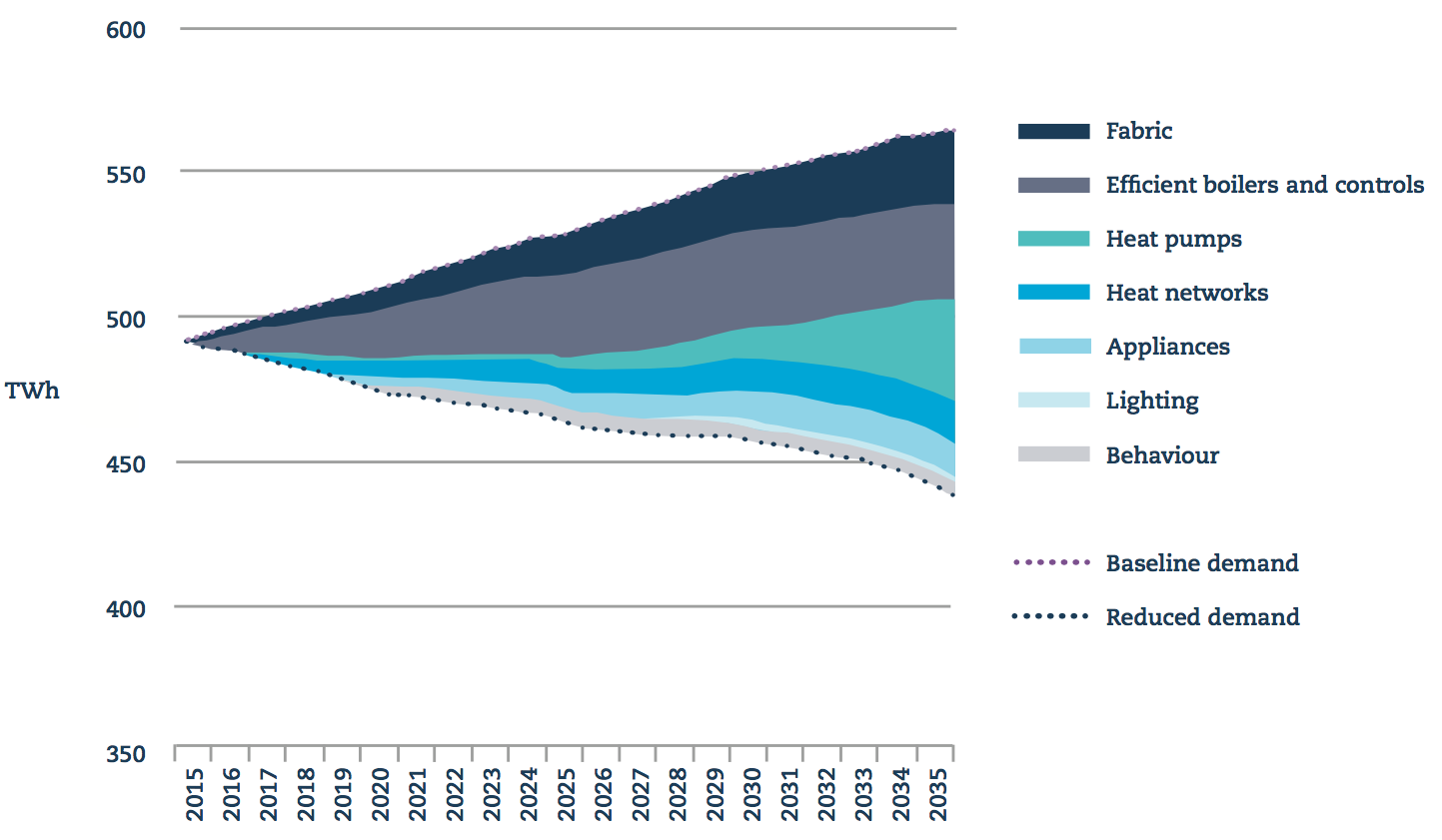
Household energy demand in the baseline and “cost-effective” scenarios up to 2035. Source: UKERC 2017.
As the chart shows, under this scenario energy demand in 2035 would be reduced by 140TWh per year – approximately equivalent to the annual energy output of six nuclear power stations the size of Hinkley C.
Almost half of the total savings would be achieved through building fabric improvements, such as installing better loft insulation, along with boiler replacements and upgrades of heating controls within existing homes.
Heat pumps and heat networks also deliver significant improvements, while energy efficient appliances and lighting provide a tenth of the savings.
Costs versus benefits
The chart below compares the costs and benefits of the “cost-effective” scenario up to 2035, using the Treasury’s “Green Book” guidelines for policy appraisal.
The £85bn cumulative cost of energy efficiency measures (dark blue wedge) is more than offset by reduced energy use and other savings linked to the benefits of lower emissions, increased comfort and better air quality (lighter blue wedges).
This scenario offers a net saving of £7.5bn (brown line), once the costs and benefits are weighed up and discounted into today’s money
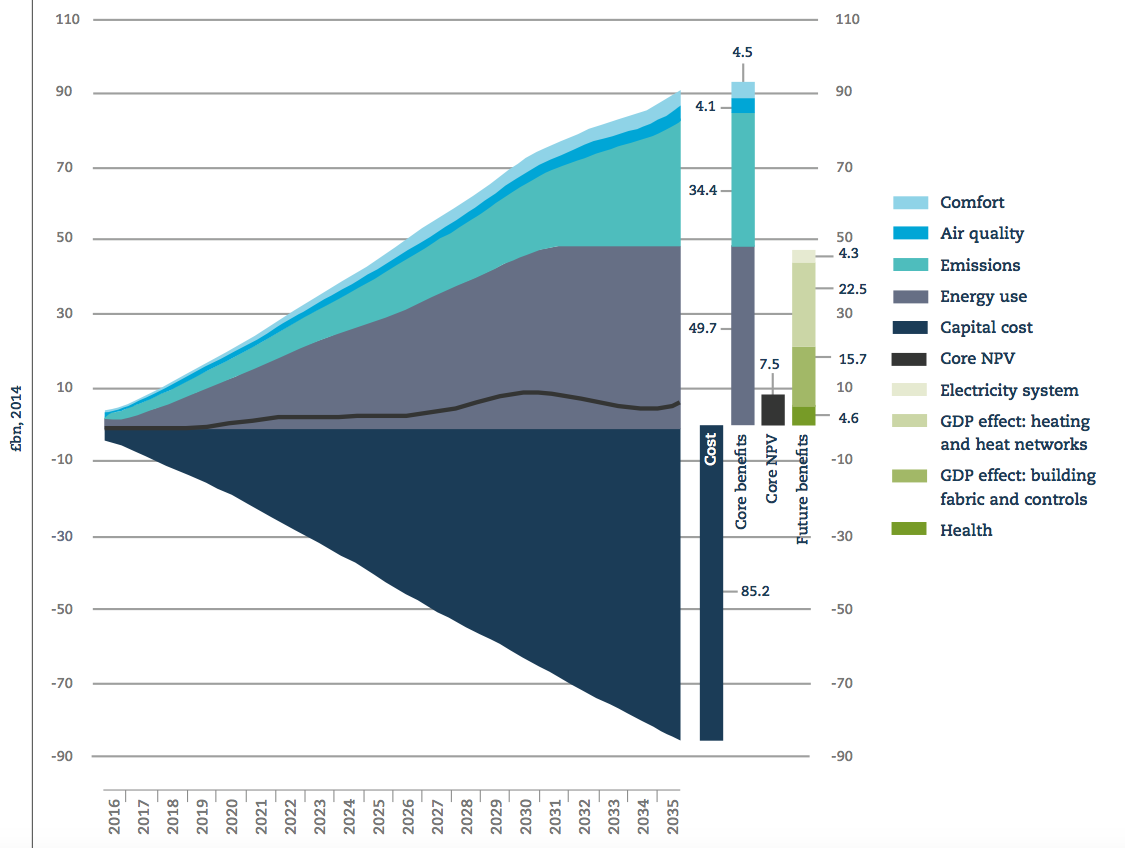
Cumulative costs and benefits of housing stock investment in the “cost-effective” scenario. Source: UKERC 2017.
The potential savings from “cost-effective” energy efficiency measures could be even larger, reaching £47bn, the report suggests ((green bars in the chart above).This assessment goes beyond government policy appraisal guidelines, however. For example, it attempts to value improved health and electricity system benefits, such as avoided network investment.
(The report notes that these benefits may be partially additional to or trade-offs with others.
Speaking to journalists ahead of the report launch, co-author Dr Jan Rosenow, a senior research fellow at the University of Sussex, notes that since many of the benefits to energy efficiency are public benefits there is a strong need for policy support. He said:
“It needs public investment and public intervention otherwise it’s unlikely to happen. And it needs a long term target and a long term commitment to the level of ambition that needs to be reached.
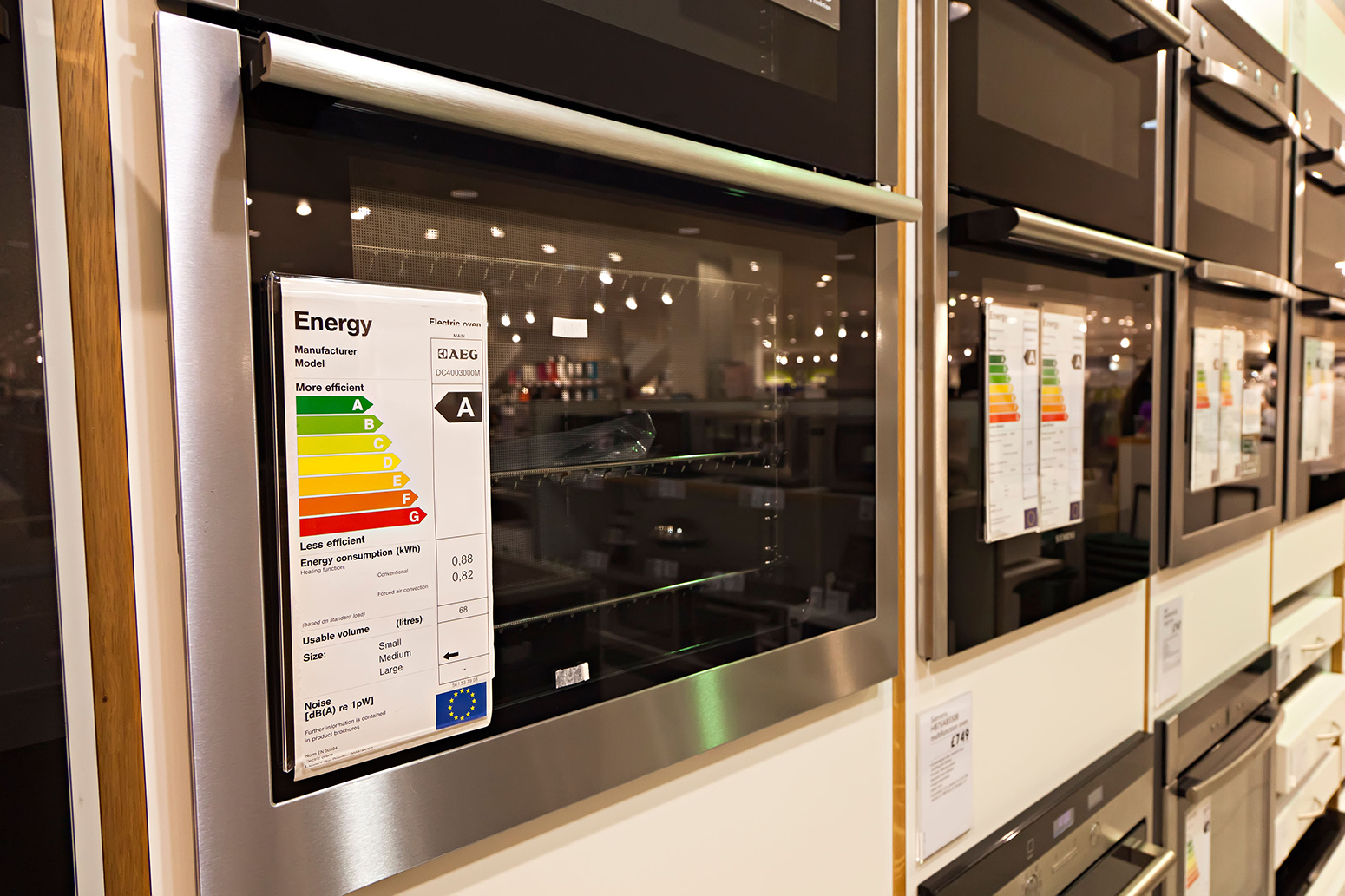
Energy efficiency rating on electric ovens in store UK. Credit: Chris Howes/Wild Places Photography / Alamy Stock Photo.
One example of a long term goal could be for all houses to reach a certain energy performance certificate standard by a given date, notes another co-author, Nick Eyre, professor of energy and climate policy at the University of Oxford. He said:
“Then at least there would be an end point to build a path to. At the moment we don’t even know where we’re going, and I think it’s probably sensible to work out where we’re going before we work out how we get there.”
Known technology
The report sets out two alternatives to its “cost-effective” scenario.
The ‘limited ambition’ scenario only includes measures that cost less than the energy they save, discounted over their lifetime. It’s worth noting, as the report points out, that even this scenario is currently uncertain. Rosenow tells Carbon Brief:
“I don’t think you would achieve the limited ambition scenario just by keeping going with current policies…my impression would be that’s highly unlikely.”
Meanwhile, the ‘current technical potential’ scenario includes all present measures that could improve home energy efficiency, without regard to their cost.
As the chart below shows, much of this technical potential is not currently cost-effective, particularly for electric heat pumps and centralised heat networks.
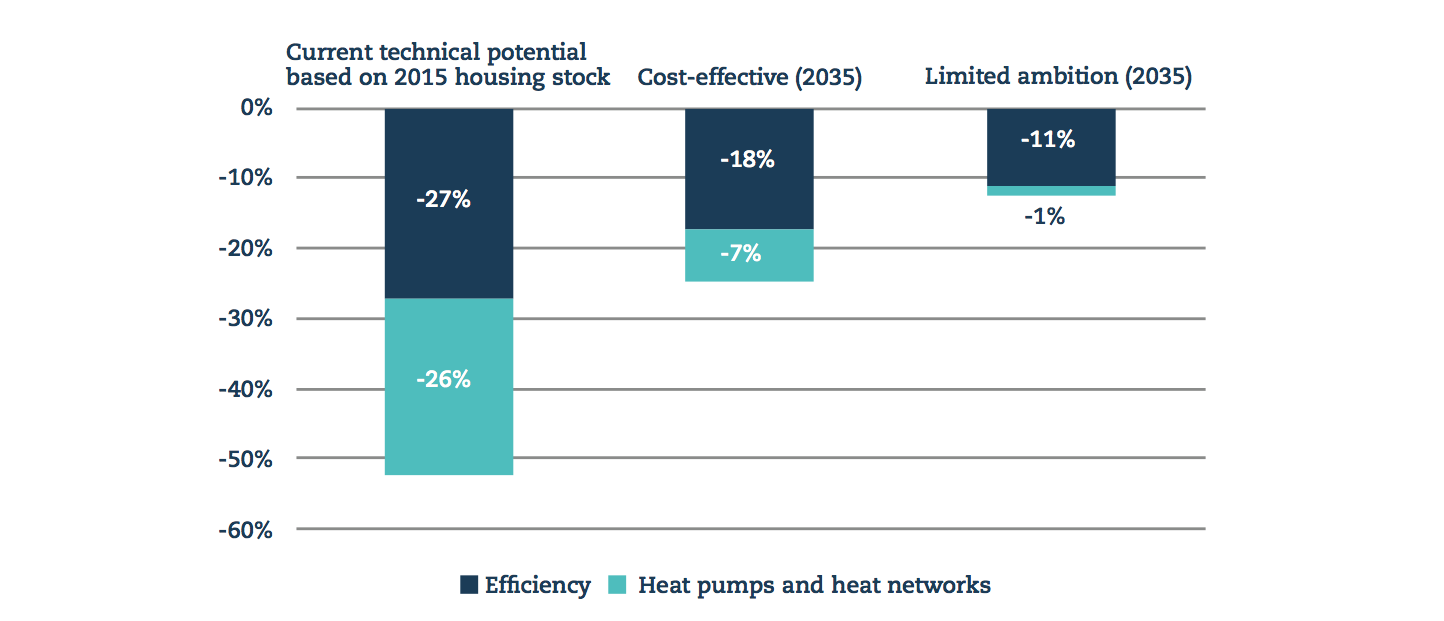
Potential energy savings in the UK’s existing housing stock, as a percentage of 2015 final energy demand. Source: UKERC 2017.
In short, the report suggests energy use in UK housing could be halved with known technology, if costs are not considered.
The report’s authors say they expect costs to fall with increased deployment, improving cost-effectiveness over time. This could also justify support for initial deployment.
Speaking to journalists ahead of the report launch, co-author Jim Watson, professor of energy policy at the University of Sussex and director of UKERC, said:
“To an extent efficiency has often been talked about as this cheap stuff, the low hanging fruit, and therefore it gets talked about very differently to something like offshore wind or nuclear or supply technologies.
“But actually, if you look at [efficiency policy] as a process of commercialising products, you can think of it in a similar way: you need research to develop your 1cm thin internal insulation, then you need government policies to scale that up to demonstration to learn and then incentives to grow the market.
“That requires just the same in efficiency as it does in something like offshore wind, where successive government policies have been very successful and now we’re seeing cost reductions.”
Big potential
Some energy efficiency measures are already cost effective whereas others will take time to develop. The figure shows the overall potential of 15 different measures (the numbers on the left) and the proportion installed under each scenario (coloured bars).
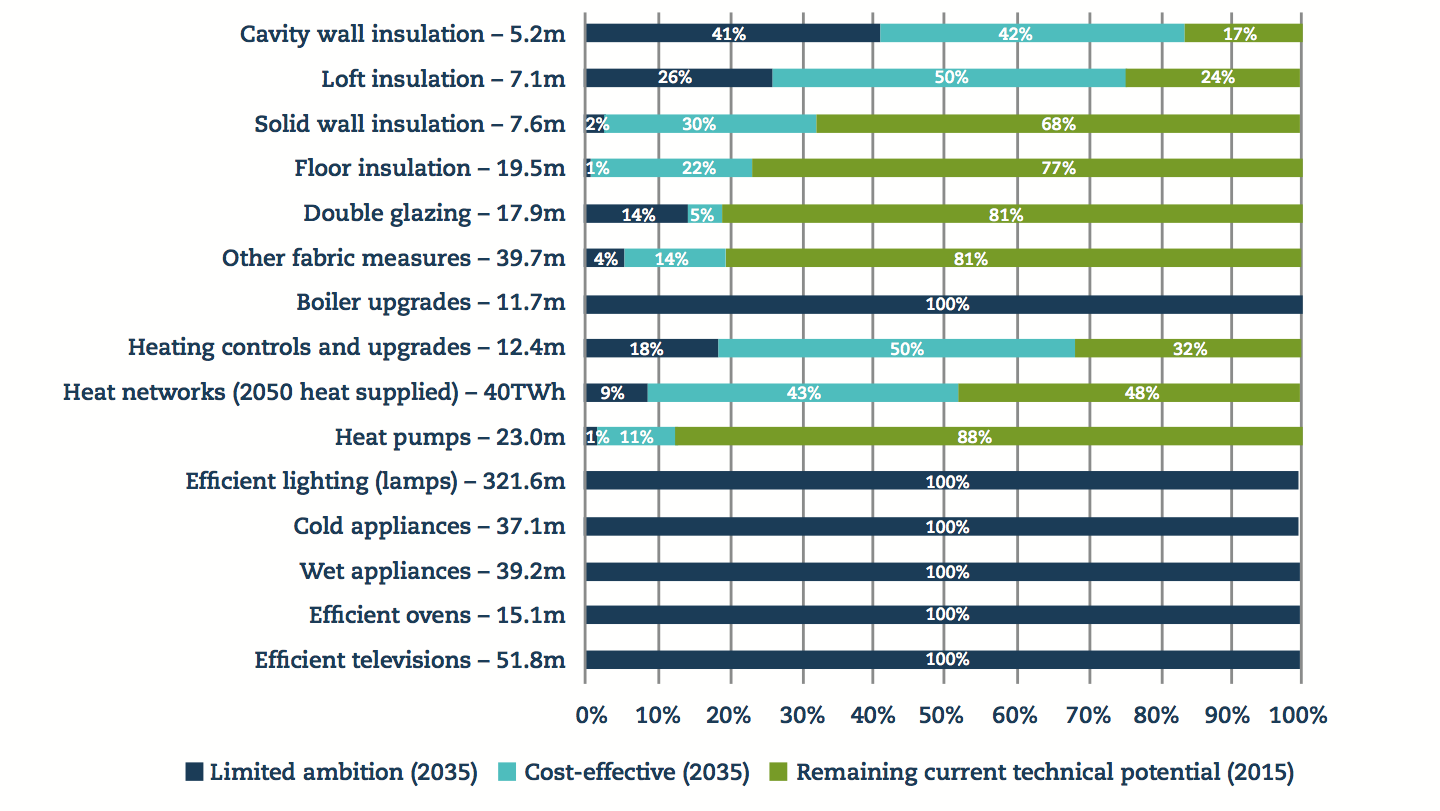
Potential scale of 15 different energy efficiency measures (left). The bars show the proportion of those measures that would be installed by 2035 under “limited ambition” (dark blue), the “cost-effective” scenario (light blue) and the remaining “current technical potential” (green). Source: UKERC 2017.
More efficient televisions and ovens, for example, are already cost-effective, meaning they are worth the investment based only on the energy they will save. Almost 52m TVs and 15m ovens could be replaced with more efficient models.
In contrast, it is not currently cost-effective to install a heat pump in 88% of the homes where they could be fitted. This is the case even when monetary value is put on things like comfort and reducing carbon emissions.
The case for policy
Energy efficiency is often overlooked as an area for strong policy intervention to cut carbon emissions, in favour of energy supply technologies such as wind, solar or nuclear. But the UKERC report argues that it should be treated in a similar way.
This would mean setting a long term energy efficiency target and then crafting policy to meet it.
Energy efficiency delivers wider societal benefits not necessarily captured by individual households, such as savings for the NHS This makes the rationale for government intervention stronger than for measure taken by individual households , the report adds.

